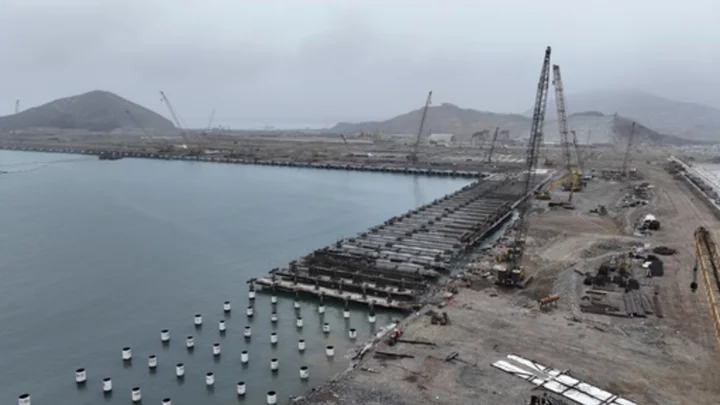CHANCAY, Peru (AP) — Dozens of cranes lift blocks weighing several tons and drop them to compact the soil of a roughly one-square-mile area on Peru’s Pacific coast, part of China’s most ambitious port project in Latin America designed to facilitate trade between the regions.
The port of Chancay, 60 kilometers (37 miles) north of the Peruvian capital of Lima, will be “the gateway from South America to Asia,” said Mario de las Casas, institutional affairs manager of COSCO Shipping, a Chinese state-owned company that is the majority owner of the project.
De las Casas said the $1.3 billion project will offer a direct route to China with a travel time reduction for ships of 10 days. COSCO officials say ships traveling from South America to China normally take more than 45 days with stops in Central America, Mexico or the United States.
Offering a deep water port, Chancay will be able to handle container ships that can’t dock elsewhere in South America.
De las Casas said the port is part of China’s Belt and Road Initiative. “China has been investing in infrastructure and logistics around the world for years. There are ports in Greece, in Spain, in Africa, all over the world."
Isaac B. Kardon, a senior fellow at the Carnegie Endowment for International Peace - who has researched China’s maritime affairs - estimated that as of July 2020 there were at least 95 ports in the world operated in whole or in part by Chinese capital.
Kardon, formerly an adjunct professor at the U.S. Naval War College’s China Maritime Studies Institute, said “Chancay is a strategic investment for COSCO, China’s largest and most globally competitive state-owned shipping company.”
“This long-term project reflects a concerted Chinese strategy to extend its maritime trade and logistics footprint to all of the key maritime points on the globe,’ he said.
This global port gamble by Chinese firms is raising concerns among U.S. officials.
“I see the concern from a commercial point of view,” said De las Casas, the COSCO official, pointing out that the Chinese state-owned company is present in 37 ports around the world, including in Los Angeles, California.
COSCO Shipping holds a 60% stake in the Chancay port with Peru’s Volcan holding the other 40%.
Its first stage is to be completed by the end of 2024. The containers will arrive at and leave the port through a 1.8-kilometer tunnel, the construction of which was halted in May following the collapse of part of the surface.
The company says work in the tunnel area will resume in the next few days.

